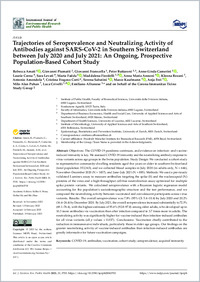Trajectories of seroprevalence and neutralizing activity of antibodies against SARS-CoV-2 in Southern Switzerland between July 2020 and July 2021 : an ongoing, prospective population-based cohort study
- Amati, Rebecca ORCID Institute of Public Health (IPH), Università della Svizzera italiana, Switzerland
- Piumatti, Giovanni Fondazione Agnelli, Italy
- Franscella, Giovanni Institute of Public Health (IPH), Università della Svizzera italiana, Switzerland
- Buttaroni, Peter Facoltà di scienze informatiche, Università della Svizzera italiana, Svizzera
- Camerini, Anne-Linda ORCID Institute of Public Health (IPH), Università della Svizzera italiana, Switzerland
- Corna, Laurie Department of Business Economics, Health and Social Care, University of Applied Sciences and Arts of Southern Switzerland, Switzerland
- Levati, Sara Department of Business Economics, Health and Social Care, University of Applied Sciences and Arts of Southern Switzerland, Switzerland
- Fadda, Marta ORCID Institute of Public Health (IPH), Università della Svizzera italiana, Switzerland
- Fiordelli, Maddalena ORCID Institute of Public Health (IPH), Università della Svizzera italiana, Switzerland
- Annoni, Anna Maria Institute of Public Health (IPH), Università della Svizzera italiana, Switzerland
- Bezani, Kleona Institute of Public Health (IPH), Università della Svizzera italiana, Switzerland
- Amendola, Antonio Department of Business Economics, Health and Social Care, University of Applied Sciences and Arts of Southern Switzerland, Switzerland
- Fragoso Corti, Cristina Institute of Microbiology, University of Applied Sciences and Arts of Southern Switzerland, Bellinzona, Switzerland
- Sabatini, Serena ORCID Institute of Public Health (IPH), Università della Svizzera italiana, Switzerland
- Kaufmann, Marco Epidemiology, Biostatistics and Prevention Institute, University of Zurich, Switzerland
- Frei, Anja Epidemiology, Biostatistics and Prevention Institute, University of Zurich, Switzerland
- Puhan, Milo Alan Epidemiology, Biostatistics and Prevention Institute, University of Zurich, Switzerland
- Crivelli , Luca ORCID Institute of Public Health (IPH), Università della Svizzera italiana, Switzerland - Department of Business Economics, Health and Social Care, University of Applied Sciences and Arts of Southern Switzerland, Manno, Switzerland
- Albanese, Emiliano ORCID Institute of Public Health (IPH), Università della Svizzera italiana, Switzerland
- 2023
Published in:
- International Journal of Environmental Research and Public Health. - 2023, vol. 20, p. 3703
English
The COVID-19 pandemic continues, and evidence on infection- and vaccine-induced immunity is key. We assessed COVID-19 immunity and the neutralizing antibody response to virus variants across age groups in the Swiss population. Study Design: We conducted a cohort study in representative community-dwelling residents aged five years or older in southern Switzerland (total population 353,343), and we collected blood samples in July 2020 (in adults only, N = 646), November–December 2020 (N = 1457), and June–July 2021 (N = 885). Methods: We used a previously validated Luminex assay to measure antibodies targeting the spike (S) and the nucleocapsid (N) proteins of the virus and a high-throughput cell-free neutralization assay optimized for multiple spike protein variants. We calculated seroprevalence with a Bayesian logistic regression model accounting for the population’s sociodemographic structure and the test performance, and we compared the neutralizing activity between vaccinated and convalescent participants across virus variants. Results: The overall seroprevalence was 7.8% (95% CI: 5.4–10.4) by July 2020 and 20.2% (16.4–24.4) by December 2020. By July 2021, the overall seroprevalence increased substantially to 72.5% (69.1–76.4), with the highest estimates of 95.6% (92.8–97.8) among older adults, who developed up to 10.3 more antibodies via vaccination than after infection compared to 3.7 times more in adults. The neutralizing activity was significantly higher for vaccine-induced than infection-induced antibodies for all virus variants (all p values < 0.037). Conclusions: Vaccination chiefly contributed to the reduction in immunonaive individuals, particularly those in older age groups. Our findings on the greater neutralizing activity of vaccine-induced antibodies than infection-induced antibodies are greatly informative for future vaccination campaigns.
- Collections
- Language
-
- English
- Classification
- Medicine
- License
- Open access status
- gold
- Identifiers
-
- DOI 10.3390/ijerph20043703
- ARK ark:/12658/srd1331793
- Persistent URL
- https://n2t.net/ark:/12658/srd1331793
Statistics
Document views: 53
File downloads:
- Albanese_2023_MDPI_ijerph_Trajectories of seroprevalence: 22
